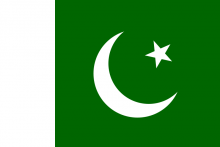I bought a map from 1937 the other day at an antique shop. It's a fascinating map--the individual who owned it first drew swastikas on the countries as they were taken over by the Nazis at the end of the 1930's and into the 1940's. But the thing that I didn't quite remember was that at this time in history, India was even huger than it is now. There is no Bangladesh or Pakistan. Along with India, Pakistani states gained their independence from Britain in 1947. It became an independent Islamic state in 1956. Bangladesh was granted its independence from Pakistan in 1971. The history of the creation of Pakistan is one we often forget, so here's a reminder:
A conflict in Kashmir in 1947, between Muslim and Hindu countries, began the first war of the India-Pakistan wars. These wars, with violent battles in 1947-48, 1965, and 1971, lasted throughout the majority of the twentieth century. The 1947 uprising, caused by a series of agreements between the state of Kashmir and both India and Pakistan, created discord between Hindus and Muslims and also Indians and Pakistanis.
In August of 1947, Great Britain formed their holdings on the Indian subcontinent into two independent countries, India and Pakistan. The five hundred and sixty-five states previously belonging Great Britain were given the choice to become part of either Pakistan or India.
Many states, ruled mainly by princes, made their decision mostly based on religion. If the majority of the state’s citizens were Muslim, that state would become a part of Muslim Pakistan. If the majority of the state’s citizens were Hindu, that state would become a part of Hindu India.
Maharaja Hari Singh, ruler of the two states of Jammu and Kashmir, couldn’t decide which country to join because he was a Hindu, but the majority of his population was Muslim. Instead of joining a country, Singh signed a “standstill” with Pakistan stating normal Kashmir-Pakistan relations would continue. Singh didn’t sign a similar agreement with India.
Soon after, aided by Pashtun tribesmen from Pakistan, Kashmiri Muslims rebelled against their ruler. Singh requested help from India. In return for their aid, Singh approved an agreement with the Governor General of India. This agreement, called the Instrument of Accession act, allowed Kashmir to be ruled temporarily by India.
Pakistan hotly contested the Instrument of Accession Act. Pakistanis said Singh couldn’t sign any such agreement under the terms of the “standstill” act with Pakistan. Pakistan argued Kashmir should’ve been a part of Pakistan because the majority of Kashmir residents were Muslim).
Despite dispute over the legality of the Instrument of Accession Act, Singh’s requested Indian aid came to the rescue in Kashmir. Indians fought the Pashtun “volunteers” until they left the country. More conflicts, in Punjab and Bengal, ensued in the following months.
This clash caused one of the greatest human migrations in history. Twelve million people became refugees as Indian Muslims fled to Pakistan and Pakistani Hindus went to India. One estimation says more than five hundred thousand people died on their journey.
